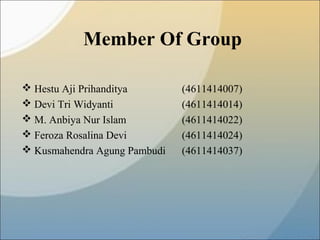
Material Architecture and organization of computer
- 1. Member Of Group Hestu Aji Prihanditya (4611414007) Devi Tri Widyanti (4611414014) M. Anbiya Nur Islam (4611414022) Feroza Rosalina Devi (4611414024) Kusmahendra Agung Pambudi (4611414037)
- 2. Storage (Pimary/Secondary Memory) Storage (Pimary/Secondary Memory) Input OutputProcesorProcesor HOW THESE COMPUTER WORKS? Monitor, Printer CPU must be connected to input device, output device and storage device to carry out the activities DataData InformationInformation INFORMATION PROCESSING CYCLE DataData InformationInformation
- 4. The Central processing Unit • The CPU interprets instructions to the computer, performs the logical and arithmetic processing operations, and causes the input and output operations to occur. • Consists of hundreds of thousands or millions of electronic circuits. • In today's PCs the CPU is contained in a single silicon chip called a microprocessor chip • It is considered the “brain” of the computer. • Also called the CPU as PROCESSOR & MICROPROCCESSOR
- 5. Intel Pentium D AMD Athlion 64 Intel Pentium M
- 6. Pentium D Pentium I-IV Pentium M Celeron Core i7 Core 2 Duo
- 7. AMD Athelon 64 X2 Athelon 64 Turion 64 Sempron
- 8. Processor / CPU The Control processing unit (CPU) controls all activities within the system. For every instruction, the control unit repeats a set of four basic operations called the MACHINE CYCLE a CPU consists of two subcomponents:- 1. Control Unit (CU) 2.Arithmetic Logic Unit (ALU).
- 9. Control Unit Control Unit’s main function in CPU to process data. 1. The Control Unit extracts instructions from memory and decodes and executes them. 2. Manages all resources of a computer 3. Manages a 4-step basic operation which is called a machine cycle or processing cycle.
- 10. The Arithmetic-Logic Unit and Control Unit • An arithmetic logic unit (ALU) and control unit is one of the core components of all central processing units. • Arithmetic operations: e.g., add, subtract, multiply, divide, square root, cosine, etc. • Logical operations: e.g., compare two numbers to see which is greater, check whether a true/false statement is true, etc. • Comparison operation : e.g:AND, OR, NOT, NAND, NOR, XOR and equacalence (=)
- 11. Signals An ALU has a variety of input and output nets, which are the shared electrical connections used to convey digital signals between the ALU and external circuitry. When an ALU is operating, external circuits apply signals to the ALU inputs and, in response, the ALU produces and conveys signals to external circuitry via its outputs. Data A basic ALU has three parallel data buses consisting of two input operands (A and B) and a result output (Y). Each data bus is a group of signals that conveys one binary integer number.
- 12. Opcode The opcode input is a parallel bus that conveys to the ALU an operation selection code, which is an enumerated value that specifies the desired arithmetic or logic operation to be performed by the ALU. Status The status outputs are various individual signals that convey supplemental information about the result of an ALU operation. These outputs are usually stored in registers so they can be used in future ALU operations or for controlling conditional branching.
- 13. General-purpose ALU commonly have status signals such as: a. Carry-out, which conveys the carry resulting from an addition operation, the borrow resulting from a subtraction operation, or the overflow bit resulting from a binary shift operation. b. Zero, which indicates all bits of the Y bus are logic zero. c. Negative, which indicates the result of an arithmetic operation is negative. d. Overflow, which indicates the result of an arithmetic operation has exceeded the numeric range of the Y bus. e. Parity, which indicates whether an even or odd number of bits on the Y bus are logic one.
- 14. Function of Control Unit • The control unit directs the entire computer system to carry out stored program instructions. • The control unit must communicate with both the arithmetic logic unit (ALU) and main memory. • The control unit instructs the arithmetic logic unit that which logical or arithmetic operation is to be performed. • The control unit co-ordinates the activities of the other two units as well as all peripherals and auxiliary storage devices linked to the computer.
- 16. Machine Cycle 4 step in Machine Cycle : • Step 1: Fetch – retrieve an instruction from memory Fetch is dealing with retrieving an instruction from main memory. After an instruction is fetched, the PC is incremented in memory locations. •Step 2: Decode – translate instruction in a form ALU can understand (command ) Decoder fetches data is broken up into parts which are related to other portions of the CPU, this is termed as opcode, indicates which operation to perform.
- 17. Step 3: Execute – Carry out instruction After decode steps, the execute step is performed. During this step, various portions of the CPU are connected so they can perform the desired operation. Step 4: Store – copy results to Memory
- 18. Processor Control Unit MEMORY ALU How it’s work ? Step 1. Fetch Calls an instruction into memory. User want to calculate 2 +2 Step 2. Decode Translate instruction into commands (to binary form) Eg : 1110000 Step 4. Store Write result to memory Step 3. Execute Does the decoded instruction Add 2+2 Four operations of the CPU comprise a machine cycle
- 19. Factors Affecting Processing Speed • Clock rate of the CPU • Computer word size • Bus speed • Main memory size • Cache memory size • instruction set complexity • Number of processing units
- 20. TERIMAKASIH
Hinweis der Redaktion
- Storage Devices
